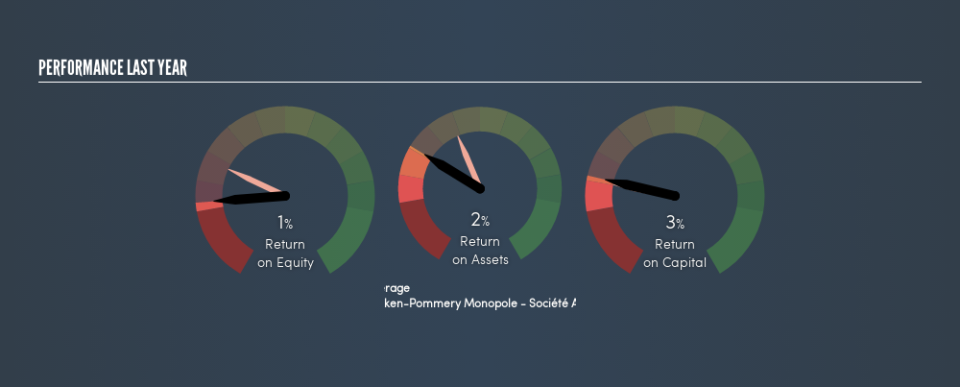How Do Vranken-Pommery Monopole - Société Anonyme’s (EPA:VRAP) Returns Compare To Its Industry?

Today we are going to look at Vranken-Pommery Monopole - Société Anonyme (EPA:VRAP) to see whether it might be an attractive investment prospect. Specifically, we're going to calculate its Return On Capital Employed (ROCE), in the hopes of getting some insight into the business.
First up, we'll look at what ROCE is and how we calculate it. Then we'll compare its ROCE to similar companies. And finally, we'll look at how its current liabilities are impacting its ROCE.
What is Return On Capital Employed (ROCE)?
ROCE measures the amount of pre-tax profits a company can generate from the capital employed in its business. In general, businesses with a higher ROCE are usually better quality. Ultimately, it is a useful but imperfect metric. Renowned investment researcher Michael Mauboussin has suggested that a high ROCE can indicate that 'one dollar invested in the company generates value of more than one dollar'.
So, How Do We Calculate ROCE?
Analysts use this formula to calculate return on capital employed:
Return on Capital Employed = Earnings Before Interest and Tax (EBIT) ÷ (Total Assets - Current Liabilities)
Or for Vranken-Pommery Monopole - Société Anonyme:
0.028 = €24m ÷ (€1.3b - €406m) (Based on the trailing twelve months to December 2018.)
Therefore, Vranken-Pommery Monopole - Société Anonyme has an ROCE of 2.8%.
Want to participate in a short research study? Help shape the future of investing tools and you could win a $250 gift card!
See our latest analysis for Vranken-Pommery Monopole - Société Anonyme
Does Vranken-Pommery Monopole - Société Anonyme Have A Good ROCE?
When making comparisons between similar businesses, investors may find ROCE useful. In this analysis, Vranken-Pommery Monopole - Société Anonyme's ROCE appears meaningfully below the 5.1% average reported by the Beverage industry. This could be seen as a negative, as it suggests some competitors may be employing their capital more efficiently. Putting aside Vranken-Pommery Monopole - Société Anonyme's performance relative to its industry, its ROCE in absolute terms is poor - considering the risk of owning stocks compared to government bonds. Readers may wish to look for more rewarding investments.
When considering this metric, keep in mind that it is backwards looking, and not necessarily predictive. Companies in cyclical industries can be difficult to understand using ROCE, as returns typically look high during boom times, and low during busts. This is because ROCE only looks at one year, instead of considering returns across a whole cycle. Since the future is so important for investors, you should check out our free report on analyst forecasts for Vranken-Pommery Monopole - Société Anonyme.
What Are Current Liabilities, And How Do They Affect Vranken-Pommery Monopole - Société Anonyme's ROCE?
Liabilities, such as supplier bills and bank overdrafts, are referred to as current liabilities if they need to be paid within 12 months. Due to the way the ROCE equation works, having large bills due in the near term can make it look as though a company has less capital employed, and thus a higher ROCE than usual. To check the impact of this, we calculate if a company has high current liabilities relative to its total assets.
Vranken-Pommery Monopole - Société Anonyme has total liabilities of €406m and total assets of €1.3b. As a result, its current liabilities are equal to approximately 32% of its total assets. With a medium level of current liabilities boosting the ROCE a little, Vranken-Pommery Monopole - Société Anonyme's low ROCE is unappealing.
What We Can Learn From Vranken-Pommery Monopole - Société Anonyme's ROCE
This company may not be the most attractive investment prospect. You might be able to find a better investment than Vranken-Pommery Monopole - Société Anonyme. If you want a selection of possible winners, check out this free list of interesting companies that trade on a P/E below 20 (but have proven they can grow earnings).
If you like to buy stocks alongside management, then you might just love this free list of companies. (Hint: insiders have been buying them).
We aim to bring you long-term focused research analysis driven by fundamental data. Note that our analysis may not factor in the latest price-sensitive company announcements or qualitative material.
If you spot an error that warrants correction, please contact the editor at editorial-team@simplywallst.com. This article by Simply Wall St is general in nature. It does not constitute a recommendation to buy or sell any stock, and does not take account of your objectives, or your financial situation. Simply Wall St has no position in the stocks mentioned. Thank you for reading.

